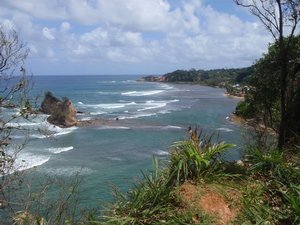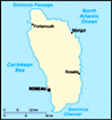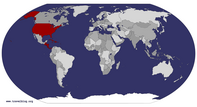Advertisement

 North Coast
North Coast
The North Coast of Dominica- spectacular!We decided to spend more time exploring Dominica but wanted to see the sights of the north end of the island, so we moved our boats up to Portsmouth. As we approached the anchorage we got a call on the vhf radio. Someone was hailing the “Boat entering Prince Rupert Bay” which is the anchorage we were heading to. So following proper radio etiquette we answered. We soon found out that it was just a local boat boy welcoming us to Portsmouth and letting us know that we can contact him if there is anything we need during our stay. We thought, well isn’t that nice. Then a few minutes later, just as we were getting ready to drop the anchor, we were approached by a couple of more boat boys. They also wanted to welcome us to Dominica and offered to take us on a tour of their beautiful island. Okay… but first let us get the anchor down and the boat all settled from our trip. Then we can talk. That is when a third boat boy approached, wanting to sell us local fruits or vegetables and even offered to take out our trash. At this point, our friendly

 Indian River
Indian River
The light changes as we enter the Indian River, giving it a magical feel.welcome to Portsmouth was starting to feel like a full blown invasion- this was getting ridiculous. We didn’t even have our anchor set before we were contacted by 3 different boat boys vying for our business. Don’t get me wrong they were all very friendly, but it was also overwhelming and we were starting to get frustrated. We know that the economy of Dominica is heavily based in tourism and that these boat boys are just trying to get their share. And according to our guide book, boat boys are on a first come first serve basis, thus you are supposed to use the first boat boy who contacts you. Unfortunately for us boaters, this makes it a feeding frenzy when you first arrive. And we have witnessed fights break out amongst the boat boys for our business. All the while we are still trying to anchor our boat. Egads!
But after all the chaos, we finally got anchored and even lined up a tour of the Indian River for the next morning. The Indian River is one of the most popular tours in Portsmouth. This small river is protected by the National Park and access is restricted to

 Blood Wood Trees
Blood Wood Trees
The river bank of the Indian River is lined with Blood Wood Trees.row boats with a local guide. So we got picked up from the Rum Runner in a small wood dinghy at 6:00 in the morning and made our way for the river. The elusive Imperial Parrot is the reason for our incredibly early departure. In February the Imperial Parrot leaves the rainforest canopy of Morne Diablotin and flies down to the Indian River below to feast on the fruits of the blood wood trees there. The best time to view the parrots is early in the morning, so we decide to make the effort. We would love to see one of these glorious birds, which are the largest in the parrot family and have bright purple plumage on their chest. They are only found in Dominica and very difficult to spot in the wild. So a chance to see them along the river would be fantastic. Unfortunately we didn’t have any luck. We saw lots of other birds, including egrets and blue herons, but no Imperial Parrots. Bummer! But the ride along the Indian River was wonderful nonetheless. We paddled up the river until we were surrounded by the rainforest canopy. The light changes as it filters thru the branches

 Roots
Roots
The roots of the Blood Wood Trees are entertwined and intricate- fascinating!to create a cathedral effect. And the banks of the river are lined with blood wood trees, which have an intricate and beautiful root system. Very fascinating! In fact the Indian River has a mythical feel to it, which is probably why it was used in the movies “Pirates of the Caribbean 2 & 3”. This is the location where they filmed the witch’s hut after Captain Jack Sparrow (Johnny Depp) was lost. Very cool!
But the Indian River is not the only reason why we came up to Portsmouth, there are lots of other areas we wanted to explore as well. So the next day we hired Dillon, one of the local guides, to take us to all the sights on land. As we have come to expect in Dominica, driving around the island is an adventure in itself. The highway dips and climbs and swerves and curls around the dramatic mountainside, opening up in many places for great vistas and scenic overlooks. We took the precarious road that runs along the rocky shoreline on the Windward Side of the island. From here we could see small coves and lovely beaches, the clear blue water of the Caribbean

 Heron
Heron
We saw lots of birds on the Indian River, but not the Imperial Parrot. Bummer!Sea which is littered with coral reefs, and the steep jagged cliffs that drop into the ocean below. Awesome! We stopped along the way to explore some old ruins including the Vielle Case Church and Melville Hall, which is an abandoned coconut plantation that dates back to the 1800s. And then we drove deep into the rainforest where Dillon would stop the car along the way to teach us about the local flora. We collected lemon grass and bay leaves; learned about bananas and the agricultural industry on the island; and saw a variety of tropical flowers, from giant crab claws to miniscule orchids. It was incredibly informative. Dillon proved to be quite the botanist, although he was never formally trained. Everything he learned was from watching and listening to his grandmother, who used to be a bush doctor. Luckily she passed down all this information, for Dillon was a wealth of knowledge.
We also learned about the history of Dominica, which is very similar to that of the other islands in the Caribbean. As the story goes, the island was first inhabited by the Arawaks Indians some 2,000 years ago. The Arawaks were a peaceful society of artists

 Rocky Shoreline
Rocky Shoreline
The dramatic vistas on the Windward Side, with the Caribbean Ocean below, littered with coral reefs and jagged peaks.and craftsman. Approximately 1,000 years later the Carib Indians left their homes in the Orinoco River Delta in Venezuela and went out to conquer the Caribbean Islands. The Caribs were fierce warriors and killed the Arawaks in their conquests of the islands. Cannibalism was common amongst the Carib Indians and they were feared by future explorers and colonists, including Columbus, the French, and the British. It was a volatile situation for the colonists, who were often attacked and killed. However, the tide of history was against the Caribs and eventually the colonist flourished. The Caribbean Islands today are populated with a blend of many cultures and the Carib customs and traditions were lost. Except in Dominica, where the Carib Indians were given a reservation on the Windward Coast. There are only 3,500 descendents of the original pre-Colombian Caribs today and they live in the Carib Territory of Dominica.
Fascinated by this history, we wanted to explore the Carib Territory. The first thing we noticed as we drove thru the region was that the Carib Indians definitely resemble their ancestors from Venezuela. They have bronze skin with Asian features and look more like Native Americans. And even though the Carib

 Vielle Case Church
Vielle Case Church
One of the oldest churches on the island, built by the French in the 1700s.communities appear no different than any other settlements on the island, they are divided up into 8 different villages and are ruled by an elected chief. We would stop along the way to talk to different people and learn about the traditional ways. We ate manioc bread, which is made from the cassava root and cooked over a fire kiln. And we were able to buy some beautiful and unique baskets from the women at the heritage center, which are made from the larouma reed with patterns distinctive to the Carib Indians. But the highlight of our trek thru the Carib Territory was watching the men build canoes the customary way. These canoes are carved by hand from the trunk of a gommier tree. A fire is built underneath the canoe to heat the wood and the dugout is filled with rocks and water to make the wood pliable and expand. It can take months to build one of the canoes, but they are a fine piece of craftsmanship and definitely seaworthy. In fact, one of these canoes sailed to Guyana from Dominica and back in 1997. It was called the Gli-Gli project to raise awareness of the Carib people

 Melville Hall
Melville Hall
Exploring the ruins of Melville Hall.and honor their traditions.
After leaving the Carib Territory, Dillon had one more special place he wanted us to see. So he took us to an area called Red Rocks. After we parked the van we hiked thru the rainforest for a short way and were astonished when the greenery gave way to the view in front of us. It was like we landed on Mars. The barren landscape was made out of red clay and had formed peaks and gulleys along the coast. It was similar to the landscape of the Grand Canyon or Zion National Park (although on a much, much smaller scale). However these red rocks were set amongst the back drop of the bright blue waters of the Caribbean Sea, which provided a striking contrast. What a unique place! We hiked around on the rocks, climbed the highest peak, and enjoyed the plethora of views. I would have never guessed that such a desolate landscape existed on such a lush island. Then again, I have come to learn that Dominica is full of surprises!
Advertisement
Tot: 0.108s; Tpl: 0.017s; cc: 13; qc: 30; dbt: 0.0773s; 1; m:domysql w:travelblog (10.17.0.13); sld: 1;
; mem: 1.1mb
















margie
non-member comment
baskets
hi, Things sound good for you.This trip sounds like real education. You have been away so long but I am sure you are forgetting about time.Love to see those baskets.xx M.